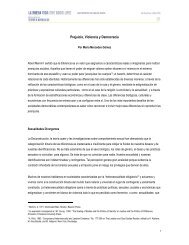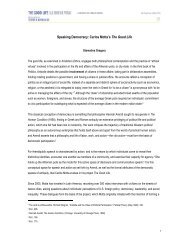Carlos Motta - La buena vida
Carlos Motta - La buena vida
Carlos Motta - La buena vida
Create successful ePaper yourself
Turn your PDF publications into a flip-book with our unique Google optimized e-Paper software.
Zócalo, México D.F., México<br />
introduction<br />
postscript:<br />
civilization or<br />
barbarity<br />
carlos motta<br />
How do you teach democracy, through the<br />
barrel of a gun?<br />
- Father Roy Bourgeois’ protest sign slogan<br />
during a manifestation against The School of<br />
The Americas in Fort Benning, GA.<br />
In 1968 Argentinean filmmaker Fernando<br />
“Pino” Solanas made <strong>La</strong> hora de los hornos<br />
(The Hour of the Furnaces), a radical<br />
political documentary and manifesto that<br />
unapologetically advocated the construction of<br />
a just society, free from the forces of bourgeois<br />
neo-colonialism and U.S. and European<br />
imperialism. This major work, emblematic of the<br />
1960s revolutionary filmmaking is a heartfelt<br />
outcry for independence. Solanas and his coscreenwriter<br />
Octavio Getino formed the Grupo<br />
Cine Liberación (Liberation Cinema Group)<br />
and went on to formulate what they called<br />
Tercer Cine (Third Cinema), a film practice that<br />
articulated the social, political and economic<br />
illnesses of the time from the perspective of<br />
“the people.” Third Cinema distanced itself from<br />
the commercial pressure of Hollywood and the<br />
seemingly uncompromised attitude of European<br />
films d’auteur. Film for them was an aesthetic<br />
instrument to politicize, liberate and to create an<br />
awakening of critical consciousness.<br />
Similarly, the work of Brazilian pedagogue<br />
Paulo Freire was motivated by the rejection<br />
of the inequalities of the established social<br />
order, which enforced an elitist “banking<br />
model” of education in which information is<br />
“deposited” into students, who are expected<br />
to digest it and act accordingly without asking<br />
any questions. Freire, alternatively, made an<br />
emphasis on dialogue and praxis as means of<br />
developing consciousness; a consciousness that<br />
is understood to have the power to transform<br />
reality. Freire, like Solanas and Getino, was<br />
interested in developing critical tools for people<br />
to use as means to liberate themselves from<br />
oppression.<br />
The decades that followed the release of <strong>La</strong><br />
hora de los hornos would witness the shattering<br />
of the filmmaker’s as well as the pedagogue’s<br />
social and political dreams. Since the 1970s,<br />
the U.S. has backed several military coups and<br />
dictatorships, civil wars, counter-revolutions, and<br />
countless other forms of intervention throughout<br />
the continent to systematically eradicate any<br />
(socialist) project that may have challenged<br />
its economic power. Today, 40 years later, <strong>La</strong>tin<br />
America is still bleeding, dependent, ignorant,<br />
violent, poor and oppressed.<br />
These works, their political and historical<br />
contexts have been important conceptual and<br />
methodological references for the making of The<br />
Good Life, a multi-part video project composed<br />
of over 400 video interviews with pedestrians on<br />
the streets of twelve cities in <strong>La</strong>tin America. The<br />
work examines processes of democratization<br />
as they relate to U.S. interventionist policies in<br />
the region. The conversations and dialogues,<br />
recorded in Bogotá, Buenos Aires, Caracas,<br />
Guatemala City, <strong>La</strong> Paz, Managua, Mexico City,<br />
Panamá City, Santiago, San Salvador, São Paulo,<br />
and Tegucigalpa, cover topics such as individuals’<br />
perceptions of U.S. foreign policy, democracy,<br />
leadership, and governance. The result is a wide<br />
spectrum of responses and opinions, which vary<br />
according to local situations and specific forms<br />
of government in each country.<br />
The work is structured in the form of an<br />
Internet Archive, which provides several ways to<br />
search through and access the material. It holds<br />
all the video interviews unedited, in an attempt<br />
to make the process of the work’s making<br />
transparent, to allow the viewers to reflect on<br />
the inherent problems of interviewing and to<br />
see the fabrication of these video “documents.”<br />
The project also wishes to maintain a critical<br />
distance from the mainstream media’s use of<br />
similar means to promote “truth” and “objective”<br />
information as well as from the notion of “public<br />
opinion.” In other words, while The Good Life<br />
uses strategies common to journalism and<br />
documentary film, it doesn’t pretend to show<br />
“reality as it is,” but rather to expose a subjective<br />
and personal interpretation of “reality as it<br />
should be.” 1 These “documents” are not neutral,<br />
and my mediation and ideology as well as that of<br />
the interviewees, are explicit.<br />
Additionally, in terms of distribution, the<br />
Internet is a platform and a way to reach a<br />
wider audience outside of the field of art<br />
(via individuals, public libraries and cultural<br />
institutions) and to make the work available to<br />
the individuals that responded to the questions.<br />
The Good Life was conceived in order to<br />
ask difficult questions today, after years of<br />
exploitation and dependency have determined<br />
the fate of the majority of citizens throughout<br />
<strong>La</strong>tin America. This work is born out of a desire to<br />
generate an inter-generational public dialogue<br />
about the actions of the U.S. and how they are<br />
perceived today, given the different degrees<br />
and levels of intervention in the region. I was<br />
interested in inquiring about the perception<br />
of political concepts such as democracy and<br />
leadership and more importantly about their<br />
implementation, considering the critical<br />
importance that these concepts play in our social<br />
development. How have these concepts been<br />
constructed in countries as diverse as Honduras<br />
or Chile, where U.S. involvement has been<br />
radically different? Can one speak of democratic<br />
nations in <strong>La</strong>tin America, a geographic region<br />
defined by social inequality? What is the role of<br />
civilians and/or social movements within the<br />
different political systems of the region?<br />
These, amongst many other questions, are<br />
part of an attempt to underline the need for a<br />
systematization of inquiry (political, social and<br />
historical) and rejection (of abuse, manipulation<br />
and violence). The proposed system doesn’t<br />
attempt to impose another hegemonic worldview<br />
but rather to magnify unheard voices and<br />
opinions about the complex set of relations that<br />
have maintained the majority of our continent<br />
poor and underrepresented. The Good Life<br />
modestly looks to re-claim my status, as well as<br />
1 Octavio Getino - Susana Vellegia, El cine de las<br />
historias de la revolución, (Grupo Editor Altamira, 2002),<br />
18.




